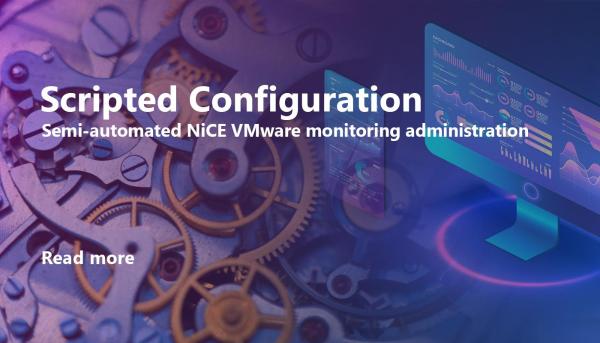Semi-automated NiCE VMware monitoring administration
Scripted Configuration of the NiCE VMware Management Pack provides a semi-automated means of setting up VMware monitoring administration with the help of approved and tested script functions. The NiCE Development Team has put together a new technical white paper for you to use automated administration easily. This article will briefly summarize what the white paper will cover.
Command Line Tools Overview
The following scripts are currently available with the new NiCE Scripted Configuration:
Add vSphere Server | Adds vCenter or ESXi hosts into the VMware Management Pack collector
Add vSphere Server With Flags | Adds vCenter or ESXi hosts into the VMware Management Pack collector with flags
Disable vSphere Host | Disables ESXi hosts to be monitored
Enable vSphere Host | Enables ESXi hosts to be monitored
Get vSphere Hosts | List all monitored ESXi hosts in the VMware Management Pack collector
Get vSphere Servers | Lists all monitored ESXi hosts and vCenters in the VMware Management Pack collector
Remove vSphere Server | Removes ESXi host or vCenter from the VMware Management Pack P collector
Update vSphere Server | Updates ESXi host or vCenter in the VMware Management Pack collector
Set Data Collection Interval | Updates data collection interval for a given managed server and given polling interval in seconds
Command Line Details
This section will discuss some of the details that come with the new Command Line tool.
1) Adding or Removing a vSphere Server
Add vSphere Server
This script can add new vSphere servers to your VMware monitoring.
Add vSphere Server With Flags
You can use this function to add a new vSphere server for management while configuring the collector with so-called “flags” to filter out specific servers. These filters are:
-
None
-
Suspend Data collection
-
Ignore failures
-
Ignore new hosts
-
Ignore new clusters
-
Ignore new datacenters
-
Check new event owner
-
Restrict events by type
-
Check task owner
Remove vSphere Server
You can use this function to remove a vSphere server from management by the given SCOM server and end its monitoring by the VMware Management Pack.
2) Showing all vSphere Servers and Hosts
There are two functions to help you quickly analyze the current monitoring status of the vSphere Servers and Hosts.
Get vSphere Servers
Lists all vSphere ESXi host systems and vCenter systems that the VMWare Management Pack collector monitors.
Get vSphere Hosts
Lists vSphere host systems managed by a server, including vSphere ESXi host system Name, Instance ID, Server ID, and whether they are currently ignored or not.
3) Switch Monitoring On / Off for a vSphere Host
Disable vSphere Host
You can use this function to quickly disable a vSphere host system from being monitored.
Enable vSphere Host
You can use this function to quickly enable a vSphere host system to be monitored.
4) Changing vSphere Objects
Update-vSphere Server
You can use this function to update an existing vSphere server. Options available are:
Tasks
-
Retrieve Tasks History (in hours)
-
Allow Only this VMware Server Tasks
New Entities
-
Ignore Newly Added VMware Hosts
-
Ignore Newly Added VMware Clusters
-
Ignore Newly Added VMware Datacenters
Existing Entities By Type
-
Ignore Virtual Machines
-
Ignore Data Store
-
Ignore Networks
-
Ignore Host Hardware
Events
-
Retrieve Event History (in hours)
Set Data Collection Interval
The default collection interval is 300 seconds. Setting it higher will collect monitoring data less often and put less strain on the SCOM and vSphere server.
Prerequisites
PowerShell 5.0 should be installed on the computer where VMware Management Pack Collector runs and where the scripts are to be executed. For successful execution, .Net Framework version 4.7.2 is also required.

